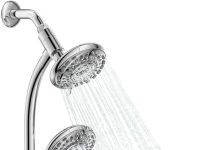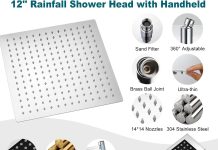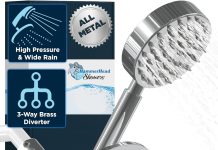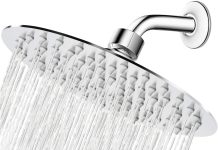So you’ve finally found the perfect shower head to amplify your daily cleansing ritual, only to be faced with the frustrating realization that it doesn’t quite fit your existing plumbing. Well, fret not, because we’re here to provide you with a range of solutions to this plumbing predicament. From simple adjustments to more complex installations, we’ll explore different options that will have you enjoying that satisfying shower experience you’ve been dreaming of. No need to stress – we’ve got you covered!
Table of Contents
Common Reasons for Shower Head and Plumbing Incompatibility
Mismatched Thread Size
One of the common reasons for shower head and plumbing incompatibility is a mismatched thread size. The thread size refers to the measurement of the ridges on the shower head and plumbing pipe that allow them to be screwed together. If the thread sizes do not match, it can be challenging or even impossible to connect the shower head properly.
Different Mounting Mechanisms
Another reason for incompatibility between a new shower head and existing plumbing is the presence of different mounting mechanisms. Some shower heads may have a wall arm mounting, while others may use a ceiling or handheld mounting mechanism. If the mounting mechanisms do not align, it can be challenging to install the new shower head onto the existing plumbing.
Compatibility with Water Pressure
The water pressure in your home can also affect the compatibility between a new shower head and your existing plumbing. Different shower heads are designed to function optimally at specific water pressure levels. If the water pressure in your home is too high or too low for the shower head you purchased, it may not perform as expected.
Compatibility with Water Flow Rate
Similarly, the water flow rate can also impact the compatibility between a new shower head and existing plumbing. Certain shower heads require a specific flow rate to function properly. If the flow rate of your plumbing system is not compatible with the shower head you want to install, it may result in inadequate water flow or excessive water usage.
Assessing the Situation
Check the Thread Size of the Shower Head
To assess the compatibility between a new shower head and existing plumbing, the first step is to check the thread size of the shower head. You can do this by examining the ridges on the base of the shower head or by referring to the product specifications provided by the manufacturer. Once you know the thread size, you can compare it to the thread size of your existing plumbing to determine if they are compatible.
Determine the Mounting Mechanism
Next, you should determine the mounting mechanism of both the new shower head and your existing plumbing. This can be done by inspecting the hardware and fittings present in your shower area. If the mounting mechanisms are different, it may require additional adjustments or replacements to make the new shower head compatible.
Evaluate the Water Pressure
To ensure compatibility, it is crucial to evaluate the water pressure in your home. You can use a water pressure gauge or consult a professional plumber to determine the current water pressure. Compare this information with the specifications provided by the manufacturer of the new shower head. If there is a significant disparity, you may need to consider additional measures to regulate the water pressure.
Consider the Water Flow Rate
In addition to water pressure, the water flow rate should also be taken into consideration. The flow rate is measured in gallons per minute (GPM) and indicates the amount of water passing through the shower head within a given time. Review the flow rate requirements of the new shower head and compare it to your current plumbing system’s capabilities. If they are incompatible, adjustments may be necessary to achieve the desired flow rate.
Possible Solutions
Using an Adapter or Converter
If the thread sizes of the new shower head and plumbing do not match, using an adapter or converter can be a suitable solution. These devices act as intermediaries, allowing you to connect components with different thread sizes. Adapters and converters are commonly available at hardware stores and can be an affordable option to resolve thread size incompatibility.
Replacing the Wall Arm
In cases where the mounting mechanisms differ, replacing the existing wall arm or plumbing fixture may be necessary. This requires additional plumbing work but can ensure compatibility between the new shower head and the plumbing. Consultation with a professional plumber is recommended if you are considering replacing the wall arm or any other plumbing components.
Adjusting the Plumbing Connections
In situations where the water pressure and flow rate are the primary concerns, adjusting the plumbing connections can help achieve compatibility. This may involve replacing or adjusting valves, pipes, or fittings to regulate the water pressure and flow rate. While this solution can be complex and time-consuming, it can provide a long-term fix for incompatibility issues.
Installing a Pressure Regulator or Flow Restrictor
To address water pressure or flow rate discrepancies, installing a pressure regulator or flow restrictor can be a viable solution. A pressure regulator helps to maintain a consistent water pressure level, while a flow restrictor reduces the water flow rate. These devices can be installed at specific points in your plumbing system to ensure compatibility with the new shower head.
Consulting a Professional Plumber
Seeking Expert Advice
If you are uncertain about the compatibility of your new shower head with your existing plumbing, it is always wise to seek expert advice. Consulting a professional plumber can provide you with valuable insights and recommendations based on their expertise. They will assess your current plumbing system, consider the specifications of your new shower head, and provide guidance on the best course of action.
Exploring Alternate Plumbing Options
In some cases, the incompatibility between a new shower head and existing plumbing may be due to limitations in your plumbing system. A professional plumber can help you explore alternative plumbing options that may better suit your desired shower head. They can suggest modifications or upgrades to your plumbing system that will ensure compatibility and optimal performance.
Dealing with Complicated Plumbing Systems
If you have a complex plumbing system or are unsure how to deal with the incompatibility issue yourself, it is advisable to consult a professional plumber. Complicated plumbing systems may require specialized knowledge and skills to address compatibility concerns effectively. A plumber can thoroughly evaluate your system, identify any underlying issues, and offer appropriate solutions tailored to your specific needs.
Conclusion
Encountering incompatibility between a new shower head and existing plumbing can be frustrating, but there are several possible solutions to address this issue. By assessing the thread size, mounting mechanism, water pressure, and water flow rate, you can determine the compatibility of the shower head with your plumbing system. If compatibility issues arise, consider using adapters, replacing the wall arm, adjusting plumbing connections, or installing pressure regulators or flow restrictors. Consulting a professional plumber is always a wise choice when dealing with complex or uncertain plumbing situations. With their expertise and guidance, you can find the best possible solution to ensure a properly functioning shower head that meets your needs and preferences.






















